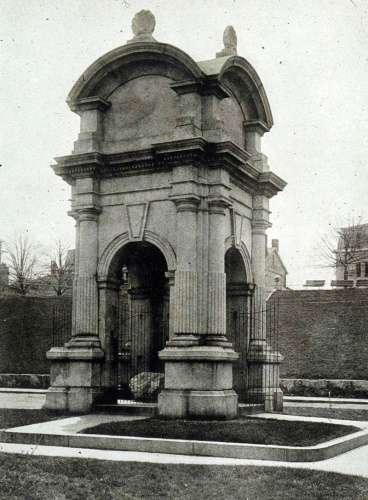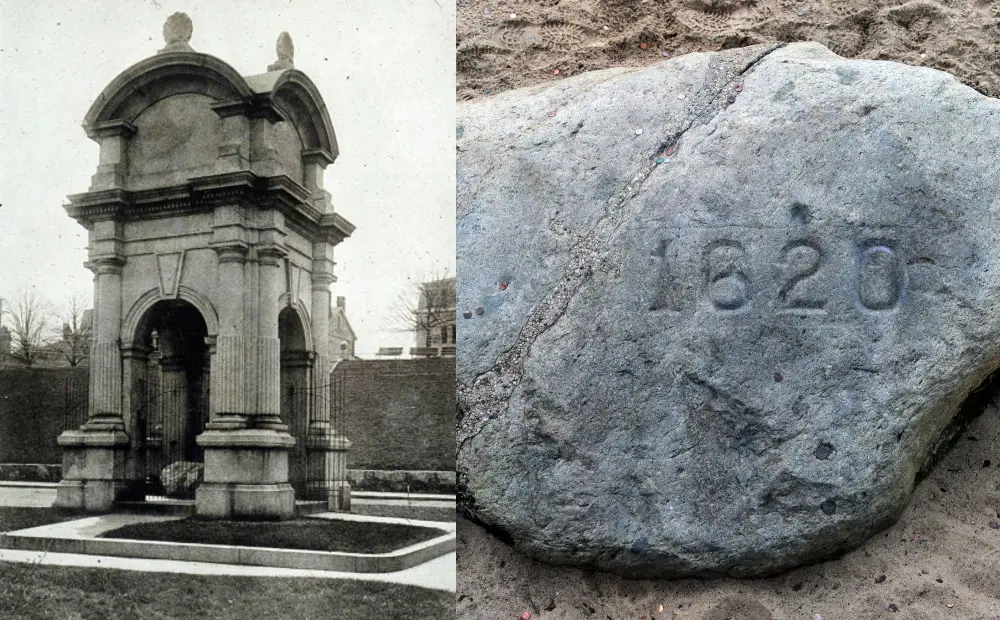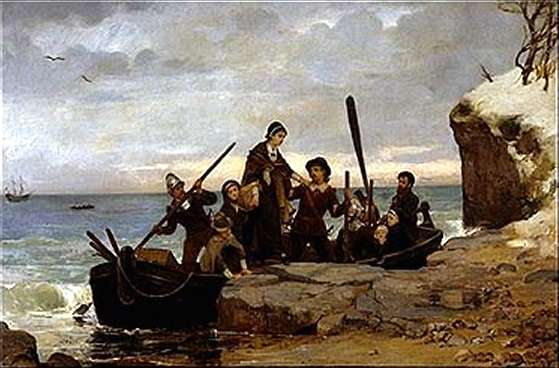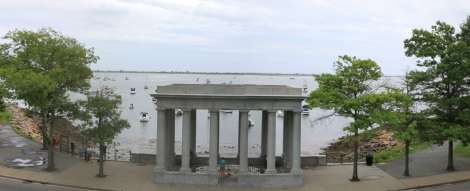In 1741, Thomas Faunce of Plymouth, Mass., had grave concerns about the town’s plans to construct a new wharf. It would, he feared, mar the very spot where the Pilgrims first set foot in Plymouth.
So at age 94, the old man was carted down to the shoreline, carried in a chair. He pointed to the very rock the Pilgrims had first set foot on. Then he wept at the prospect that the new wharf would cover the rock, losing it forever.
Thomas Faunce
Thomas Faunce had served as town clerk, and he was old enough to know what he was talking about. His father had arrived just three years after the Mayflower aboard the ship Anne. As a child, Faunce said, several of the first settlers had pointed out the rock to him, and he always remembered it.
His grandmother even admonished him to never forget that first fateful step the Pilgrims made in America.
Of course, the Pilgrims first landed in Provincetown, but they sailed on the Plymouth and settled there.

Many questions arose over the years about Faunce’s designation of the rock. The Pilgrims landed multiple times at Plymouth, and the early accounts of their arrival contain no reference to any rock. Plus, how could anyone know for certain that Thomas Faunce remembered correctly what people had told him as a child?
Nevertheless, the Pilgrim journey in America had to start somewhere and the town gave Plymouth Rock the official designation. Thomas Faunce was wrong in assuming that it would be lost, but over the years the rock has traveled a rough road.
After he pointed it out, the townspeople elevated the rock to signify its status.
Plymouth Rock
In 1774, some rebellious souls decided the rock would make the perfect platform for agitating against British rule. So they hauled the rock up from the shore to the town square, where they erected a Liberty Pole. There they used it as a stage to deliver speeches.

The Victorian canopy that sheltered Plymouth Rock until 1920.
In the process, they split the rock nearly in half. It was later dropped and broken again while being carted to a Pilgrim Hall museum.
In 1859, an architect named Hammatt Billings designed an elaborate Victorian canopy for the rock. The Pilgrim Society had it built at the wharf and in 1880 rejoined its two parts. A stonecutter chiseled 1620 into its top.
Makeover
The elaborate canopy fell out of fashion by 1920, when Plymouth celebrated the tercentenary of the Pilgrims’ arrival. The town tore down the old wharves, created a waterfront promenade and moved the rock down to the water. McKim, Mead and White designed a simpler Doric portico to protect the rock.
Over the years, the rock has lost a great deal of weight. It’s estimated that souvenir hunters chipped or broke off as much as two-thirds of the rock. Yet Thomas Faunce’s rock still survives, nearly 400 hundred years after the Pilgrims first stepped foot on it (or not).
* * *
Need some new ideas for your Thanksgiving feast? How about trying something old — and authentic — from the New England Historical Society. Now in paperback and available from Amazon (click here).
This biography of the rock assembled from History of the Town of Plymouth by James Thacher and Pilgrim Hall Museum.
Image of Plymouth Waterfront: By Linear77 – Own work, CC BY 3.0, https://commons.wikimedia.org/w/index.php?curid=34890560. Plymouth Rock By jjron – Own work, GFDL 1.2, https://commons.wikimedia.org/w/index.php?curid=19571461.
This story about Thomas Faunce was updated in 2023.




12 comments
Thomas Fucile
This is the first time I have read how “The Rock” was saved. Saw it along with my parent’s and 2 brothers long time ago.
http://www.findagrave.com/cgi-bin/fg.cgi?page=gr&GRid=13903903
[…] Pilgrims who arrived in Plymouth were a mix of people. They were led by separatists who despised the Christmas traditions of the […]
[…] 1714, the Pejepscot Company formed out of the Plymouth Colony and bought a large area of land in Maine from the Native Americans. Today it comprises Brunswick, […]
[…] years before the Pilgrims stepped on Plymouth Rock, French adventurers settled St. Croix Island in a river that divides Canada from the United […]
[…] Cushman, a descendant of Robert Cushman, one of the first Pilgrims. Her father was a poor boy from Plymouth who walked to Boston to make his fortune. He made it, then lost it and died when Charlotte was 13, […]
A great hope and inward zeal they had of laying some good foundation, or at least to make some way thereunto, for the propagating and advancing the gospel of the kingdom of Christ in those remote parts of the world; yea, though they should be but even as stepping-stones unto others for the performing of so great a work.” (William Bradford)
“Now as the people of god in old time were called out of Babylon civil, the place of their bodily bondage, and were to come to Jerusalem, and there to build the Lord’s temple, or tabernacle…so are the people of God now to go out of Babylon spiritual to Jerusalem…and to build themselves as living stones into a spiritual house, or temple, for the Lord to dwell in.” (John Robinson)[1]
Plymouth Rock has been largely discredited as the stepping stone that Pilgrims disembarked upon. In saying that the possibility that “Plymouth Rock” was placed or commissioned by surviving Pilgrims (Separatists) years possibly decades later in Plymouth should be studied.
The purpose of its placement would have been to serve as a boundary marker, memorial, Thanksgiving Stone (as the Bible calls an Ebenezer Stone). This possibility is born out of William Bradford and Pastor John Robinson’s own words describing the congregation as being symbolized as stones. Daniel 2 also describes a heavenly community represented by a stone as ending the earthly system of rule by king. I believe that the Pilgrims believed that they were that stone in Daniel 2 and they left Plymouth Rock as an eschatological marker for future Christians to know the times they were in.
Because of spending years and years practicing keeping a low profile in England and Holland and even in the New World this memorial would have gone unannounced. Buttressing this low profile would have been the damage that was done to Christendom early in Amsterdam and by one Leiden resident who made bold declarations about being the foundations of the “Earthly Kingdom Of Christ” riots ensued after their announcements. As residents of both Amsterdam and Leiden these events would have been well known to the Pilgrims causing them to avoid announcements like this.
This would also explain Faunce’s story because the stone was placed to memorialize the arrival of the Pilgrims in Plymouth probably covering or in front of the place that the Pilgrims landed on after disembarking from the Mayflower. It also explains why a beach totally devoid of boulders would have a 200 ton rock on it. The Pilgrims would not have carved a 1620 in the rock because according to Biblical tradition these rock s must be uncarved by human hands.
To verify this matter a geologist or person knowledgeable in these matters should search the locality of Plymouth to determine where such an uncarved boulder could have been dragged from. Also maybe an unexplainable non-descript expenditure in accounting records of Plymouth Plantation or the church or residents. Also a study verifying that such an undertaking could have been done with 17th century technology. This would be slightly different than the research done on Stonehenge because these rocks were quarried. Plymouth Rock would not have been quarried (for reasons I stated earlier).
This memorial would have probably been placed during the time of several events that would have confirmed Daniel 2 in the minds of the surviving Pilgrims. The English Civil War, The Execution of King Charles or Cromwell’s rise to power.
I believe that the rock is a charming legend, nothing more.
I approve. My real name.
[…] to legend, the Pilgrims set foot on Plymouth Rock in 1620. Then in the 19th century, it was encased in an elaborate Victorian canopy. Tourists […]
[…] diarist, Judge Samuel Sewall wrote in 1726 about meeting Thomas Faunce, an aged deacon in Plymouth, Mass., who knew many of the original Pilgrims. (Faunce is credited […]
Comments are closed.